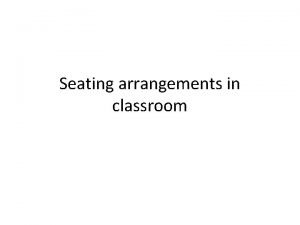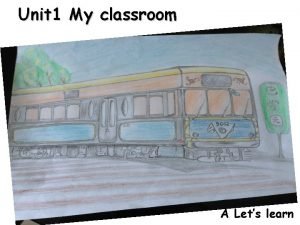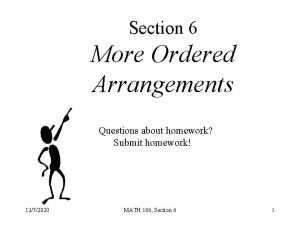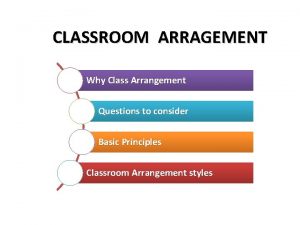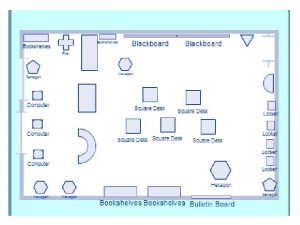CLASSROOM ARRAGEMENT Why Class Arrangement Questions to consider











- Slides: 11

CLASSROOM ARRAGEMENT Why Class Arrangement Questions to consider Basic Principles Classroom Arrangement styles

Why classroom arrangement? • The main cause of off-task behavior is classroom seating arrangement. (Bonus & Riordan, 1998). • Room arrangement affects the learning process, student behavior, and student engagement. (Florman, 2003; Lackney & Jacobs, 2002; Proshansky & Wolfe, 1974; Richards, 2006; Strong. Wilson & Ellis, 2007; Susi, 1989; Weinstein, 1977). • • We need spaces for activities To make sure that we can monitor To iptimize the teacher role and students role To avoid the teacher centredness issues

Questions to consider when arranging classroom layout: Ø Can I see the faces of every single student and can they see me? Ø Can everyone see the board (if you're planning on using it)? Ø Can the students see one another? Ø Can I move around the room so that I can monitor effectively? Ø Is the layout can facilitate the students’ activities? Ø Is there any student with special needs that I have to facilitate?

Basic Principles of Classroom Arrangement Ø Reduce congestion in high-traffic areas. Ø Make sure that you can easily see all students. Ø Make often-used teaching materials and student supplies easily accessible. Ø Make sure that students can easily observe whole-class presentations.

Classroom Arrangement Styles • Auditorium style • Face-to-face style • Off-set style • Seminar style • Cluster style

The most-often-seen classroom arrangements styles Think of the advantages and disadvantage Row seating reduces talking. (Koneya, 1976; Ridling, 1994; Silverstein & Stang, 1976; Wannarka & Ruhl, 2008; Weinstein, 1979). Row seating impedes a teachers ability to walk between student desks and assess learning. (Weaver Dunne, 2001).

Variations of Classroom Seating Arrangements

Variations of Classroom Seating The Action Zone “Action Zone” Students in these seats are more likely to interact with the teacher, ask questions, and initiate discussion.

Variations of Classroom Seating An Example of an Effective Elementary School Classroom Arrangement 9

Variations of Classroom Seating An Example of an Effective Secondary School Classroom Arrangement

Few facts about cluster seating Ø It is ideal for socially facilitated learning. (Patton, Snell, Knight & Florman 2001). Ø It promotes “innovation. ” (Raviv, Raviv & Reisel, 1990). Ø Students like each other more and communicate better when facing each other. (O’Hare, 1998; Bovard, 1951).
 Andreas carlsson bye bye bye
Andreas carlsson bye bye bye Classroom arrangement styles
Classroom arrangement styles Sourima mal
Sourima mal Dont ask why why why
Dont ask why why why Arrangement of teeth in complete denture
Arrangement of teeth in complete denture Cuspid retromolar line
Cuspid retromolar line My classroom for class 1
My classroom for class 1 Google classroom class codes
Google classroom class codes Circular arrangement questions
Circular arrangement questions Circular arrangement questions
Circular arrangement questions Circular arrangement questions
Circular arrangement questions We are going today
We are going today

